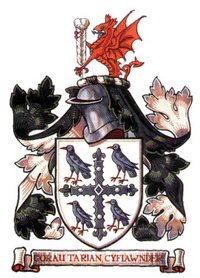Flintshire
|
|
| Flintshire principal area | |
|---|---|
| Missing image WalesFlintshire.png Image:WalesFlintshire.png | |
| Geography | |
| Area - Total - % Water | Ranked 12th 438 km² ? % |
| Admin HQ | Mold |
| ISO 3166-2 | GB-FLN |
| ONS code | 00NJ |
| Demographics | |
| Population - Total (April 29, 2001) - Density | Ranked 6th 148,594 339 / km² |
| Ethnicity | 97.8% White |
| Welsh language - Any skills | Ranked 12th 21.4% |
| Politics | |
| Flintshire County Council http://www.flintshire.gov.uk/ | |
| Control | Labour |
| MPs | David Hanson Mark Tami |
| AMs | Sandy Mewies Carl Sargeant (Constituency) North Wales (Regional) |
| MEPs | Wales |
Template:Infobox Wales traditional county
Flintshire (Welsh: Sir y Fflint) is a traditional county and principal area in northern Wales.
| Contents |
Principal area
The current administrative area of Flintshire - now known as a unitary authority - came into existence in 1996, when the former administrative county of Clwyd was split into three smaller areas.
Geography
It borders, in England, Merseyside (across the River Dee) and Cheshire, and in Wales, Wrexham and Denbighshire.
Places in the principal area include:
Traditional Flintshire
The historic county does not have the same boundaries as administrative Flintshire; in particular it has a large exclave called Maelor Saesneg, it also includes Prestatyn and Rhyl which are now administered by Denbighshire.
Geography
Flintshire is a maritime county bounded to the north by the Irish Sea, to the northeast by the Dee estuary, to the east by Cheshire and to the south and southwest by Denbighshire. Maelor Saesneg is bounded on the northwest by Denbighshire, on the northeast by Cheshire, and on the south by Shropshire. There is a further small detached part around Marford.
Flintshire is the smallest county in Wales. The coast along the Dee estuary is heavily developed by industry and the north coast much developed for tourism. The Clwydian Mountains occupy much of the west of the county. The highest point is Moel Fammau (1,820 feet). The chief towns are Bangor-is-y-coed, Buckley, Connah's Quay, Flint, Holywell, Mold, Prestatyn, Queensferry, Rhyl, Shotton and St. Asaph. The main rivers are the Dee (the estuary of which forms much of the coast) and the Clwyd. The main industries are steelworking, agriculture and tourism.
Places of special interest: Flint Castle (Template:Gbmapping); Hawarden Castle (Template:Gbmapping); Rhuddlan Castle (Template:Gbmapping); St. Asaph Cathedral (Template:Gbmapping); Sun Centre, Rhyl (Template:Gbmapping); Welsh Ewloe Castle (Template:Gbmapping); Wepre Country Park, Connah's Quay (Template:Gbmapping).
Fairtrade
On November 19, 2004, Flintshire was granted Fairtrade County status.
| United Kingdom | Wales | Principal areas of Wales | 
|
|
Anglesey | Blaenau Gwent | Bridgend | Caerphilly | Cardiff | Carmarthenshire | Ceredigion | Conwy | Denbighshire | Flintshire | Gwynedd | Merthyr Tydfil | Monmouthshire | Neath Port Talbot | Newport | Pembrokeshire | Powys | Rhondda Cynon Taff | Swansea | Torfaen | Vale of Glamorgan | Wrexham |
Template:Wales traditional countiescy:Sir y Fflint de:Flintshire fr:Sir y Fflint no:Flintshire

